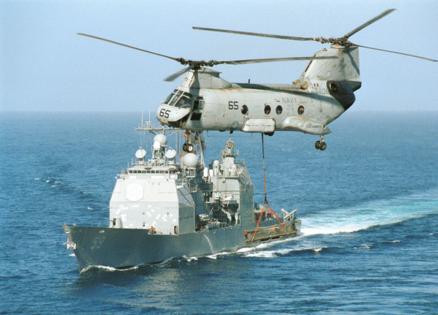Navy is retiring the last of its storied cruisers. To San Diego veterans, they were 'the pinnacle of naval power'
Published in News & Features
SAN DIEGO — Falling in love can happen in a snap. Dave Hatzenbuehler knows this from the way he responded nearly a half-century ago upon noticing a big, brooding presence in San Diego Bay.
He’d caught sight of a Navy cruiser, a famously dynamic type of ship that had been turning heads since the 1880s. This one was the USS Long Beach, a muscular brute measuring 721 feet from stem to stern. It also was the world’s first nuclear-powered missile cruiser.
“It was so powerful and sleek and beautiful,” recalled Hatzenbuehler, who was vacationing in San Diego at the time. “I joined the Navy as soon as I went home to Dallas. I wanted to be on a ship like that.”
This wasn’t a singular response, or a random one.
As the Navy nears its 250th anniversary in October, there’s a lot of reminiscing going on about the fleet. Much of it involves cruisers — renowned for shielding aircraft carriers, attacking distant enemies, flushing submarines from the deep, and roaming the seas as lone wolfs.
“They were always there to protect us when we were flying back to the carriers,” said Jack Allen of Escondido, who flew F-8 Crusaders during the Vietnam War in the 1960s. “Cruisers had a way of picking threats out of the sky.”
Now is also a bittersweet moment for current and former sailors in San Diego, the largest Navy town on the West Coast.
Cruisers helped the Navy shift from sail to steam propulsion, helped end the war in the Pacific and kept the Soviets at bay during the Cold War. But they’ve reached old age and will soon vanish from the fleet after more than 140 years of service. Replacing many of them are Arleigh Burke-class destroyers, a new type of ship whose versatility, firepower and air defense are regarded as the Navy’s best.
These days, just nine of the 27 Ticonderoga-class cruisers commissioned during the Cold War era are still in service. That number will drop to three in 2027 and zero in 2029, the Navy says.
Among the next to go will be the 36-year-old USS Princeton, which is about to return to San Diego after helping shield the carrier USS Carl Vinson during a nine-month deployment. San Diego’s other cruiser, USS Cape St. George, is expected to be one of the last to retire.
The exact timing of the shutdown isn’t clear. The Navy is struggling to conduct the maintenance its ships need to go to sea, which could further limit its use of the cruisers in the little time they have left.
There’s also a quality problem.
A recent effort to modernize 11 cruisers fell into disarray. Only three are expected to get complete upgrades, and they’ll spend less time on patrol than forecast, according to a 2024 report by the Government Accountability Office.
The project “wasted” $1.84 billion, the GAO said in unusually candid words.
This bothers many veterans, some of whom prefer to simply focus on the ships’ storied past.
“Cruisers represented the pinnacle of naval power in the world,” said Delbert Worrell of Ramona, California, who served on the USS Long Beach in the late 1970s. “I’m proud I served on one.”
Cruisers date back to the 1880s, when the Navy introduced them as iron-hulled, steam-powered ships. They had a specific purpose: protect U.S. merchant vessels and explore national interests abroad.
The first cruiser to visit San Diego was the USS California (CA-6), which arrived in 1907 and was later renamed after the city, just as the region was blooming into a Navy town.
Things literally took off in 1911. That was the year aviator Glenn Curtiss flew a seaplane from North Island on Coronado out into the harbor, where he landed in the water next to the cruiser USS Pennsylvania. The plane was hoisted aboard, then returned to the bay.
That moment suggested that planes had a place in the military. The Navy soon bought a Curtiss aircraft — a direct step toward the creation of aircraft carriers. Lumbering flattops soon appeared in ports like San Diego, and they needed escort ships.
Cruisers were perfect for the job. They were fast, highly maneuverable and regularly upgraded with a wide variety of weapons. They could defend and fight.
“We had guns, we had torpedoes, we had Harpoon missiles, we had Standard 1 missiles, we had ASROC missiles,” said Hatzenbuehler, who served on the nuclear-powered USS Texas, along with other ships, from 1980 until 2003. “We had everything.”
The cruiser’s supremacy became especially evident in World War II, when more than 80 of the ships went into service, sinking and damaging dozens of enemy vessels.
Of particular note was the USS San Diego (CL-53), the second cruiser to carry that name. It earned 18 battle stars — commendations for participating in important campaigns.
The San Diego shielded the carrier USS Hornet during the Battle of Guadalcanal, helping turn the war in the Pacific in favor of allied forces. It was the first major Allied warship to enter Tokyo Bay when the war ended.
“It terms of sheer numbers, firepower and contributions, I think the cruisers — especially when you look at World War II — really played a vital role,” said Kevin Sheehan, a historian at the Maritime Museum of San Diego.
But there were devastating losses along the way.
Components of Little Boy, the atomic bomb the U.S. dropped on Hiroshima, were quietly delivered to Tinian Island in 1945 by the cruiser USS Indianapolis. Japan sank the ship a short time later, killing 880 sailors and Marines.
These sorts of campaigns dredged up a lot of memories for naval author Kevin Eyer, a part-time San Diego resident who served on seven cruisers.
One of those ships stood out above others.
In August 1990, when Iraq invaded and annexed Kuwait, a big supplier of oil to the U.S., Eyer was a combat systems officer on the cruiser USS Antietam, operating in the Indian Ocean.
“We were directed to immediately go to the northern Persian Gulf, because the U.S. needed an adult in the room — which is how people thought about cruisers and their commanders,” he said. “We got there and were alone, which was scary. We thought Iraq might fire Exocet cruise missiles at us.
“But we also had an edge — the AEGIS Combat System, which coordinated all of the weapons systems on the ship so that they seamlessly worked in concert. Iraq ended up not attacking us. But we had AEGIS. We had a way to fight, something that’s always been true about cruisers.”
The following months involved one of the largest military buildups in U.S. history, partly due to growing concern that Iraq would attack Saudi Arabia, causing economic upheaval throughout the Middle East.
More than 170 Navy ships were dispatched to the region — including San Diego-based carrier battle groups led by the USS Ranger and by the USS Midway, which served as the flagship for naval aviation in the Persian Gulf.
Among their escorts were four cruisers. Two of them — USS Mobile Bay and USS Bunker Hill — were among the first to fire cruise missiles at Iraq when Operation Desert Storm began on Jan. 16, 1991. The USS Princeton, based in Long Beach at the time, also reached the gulf, where it struck a mine.
Cruisers continued to play key roles in the following years — notably San Diego’s USS John Paul Jones. On Oct. 7, 2001, it became the first American warship to fire Tomahawk cruise missiles into Afghanistan when the war there got underway.
But as the years passed, these ships began to fade from the scene, largely due to aging. Some developed cracks in their superstructures. The Navy decided not to build a new class of cruisers, signaling their imminent demise — the same thing that happened a decade ago, when the last of the Navy’s frigates were decommissioned.
It’s possible cruisers will, in a sense, live on. The Navy has proposed building the DDG(X), a new destroyer that would replace the last of the cruisers and older Burke destroyers. But there’s no hard and fast timetable or budget.
Eyer was in the Navy for 27 years. When asked if he thought DDG(X) would become a reality, he ran through the pros and cons, then added, “Right now, I do not know."
_____
©#YR# The San Diego Union-Tribune. Visit sandiegouniontribune.com. Distributed by Tribune Content Agency, LLC.







Comments